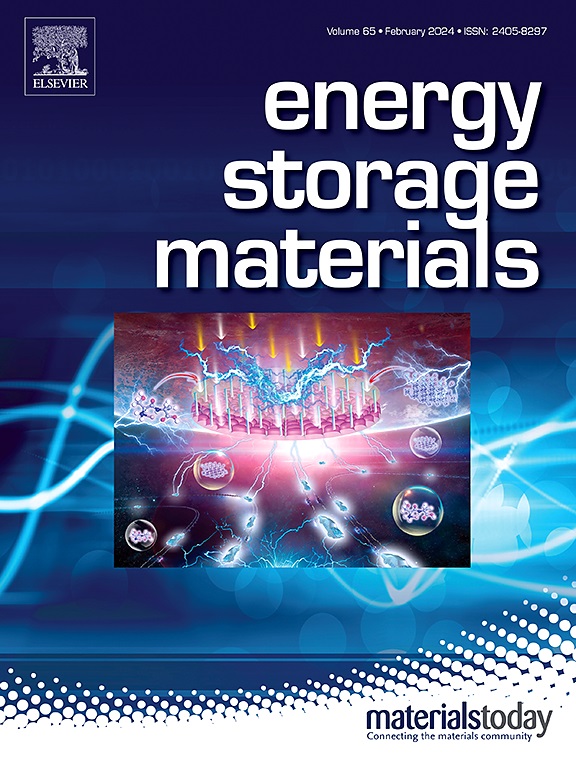颗粒级高电压LiCoO2阴极界面与结构裂纹退化模式的相互作用
IF 20.2
1区 材料科学
Q1 CHEMISTRY, PHYSICAL
引用次数: 0
摘要
提高截止电压是提高LiCoO2 (LCO)能量密度的一种很有前途的策略,与4.5 V相比,4.6 V下的放电容量增加了约22%。然而,4.5 V以上严重的结构退化和界面不稳定性阻碍了其实际应用,目前对这些机制解耦以减轻性能衰减的研究有限。本文采用电化学技术和数值模拟技术对不同粒径的LCO样品进行了系统研究,以阐明其复杂的失效模式。由于Li+扩散路径延长、锂分布不均匀和应力积累,较大尺寸的LCO颗粒表现出结构性开裂和断裂,特别是在高电流密度下。相反,较小尺寸的LCO颗粒由于其较大的表面积,特别是在低电流密度下,界面副反应会加剧。这些结果强调,LCO降解是由大小和速率相关机制的相互作用引起的,而不是单一的主导因素。为了解决这种复杂性,我们开发了一个多元非线性方程来完全解耦不同的降解机制,并成功确定了不同电流密度条件下大小LCO颗粒的最佳质量混合比,以最大限度地提高循环稳定性。这项工作为降解途径提供了有价值的机制见解,并有效地弥合了经验优化与对LCO降解的更深入理解之间的差距。本文章由计算机程序翻译,如有差异,请以英文原文为准。


Interplay of interfacial and structural cracking degradation modes for the high-voltage LiCoO2 cathode at particle’s level
Elevating the cut-off voltage is a promising strategy to enhance the energy density of LiCoO2 (LCO), as demonstrated by a ∼22 % increase in discharge capacity at 4.6 V compared to 4.5 V. However, severe structural degradation and interfacial instability above 4.5 V hinder its practical application, with limited research focusing on decoupling these mechanisms to mitigate performance decay. Herein, LCO samples with distinct particle sizes are systematically investigated by using electrochemical techniques and numerical modeling to elucidate complex failure modes. Larger-sized LCO particles exhibit structural cracking and fracture, particularly at high current density, due to prolonged Li+ diffusion pathways, inhomogeneous lithium distribution, and stress accumulation. Conversely, smaller-sized LCO particles suffer from intensified interfacial side reactions attributed to their higher surface area, especially at low current density. These results highlight that LCO degradation arises from the interplay of size- and rate-dependent mechanisms rather than a single dominant factor. To address this complexity, we develop a multivariate nonlinear equation to fully decouple different degradation mechanisms and successfully determine the optimal mass mixing ratios of larger- and smaller-sized LCO particles under various current density conditions to maximize cycling stability. This work provides valuable mechanistic insights into degradation pathways and effectively bridges the gap between empirical optimization and a deeper understanding of LCO degradation.
求助全文
通过发布文献求助,成功后即可免费获取论文全文。
去求助
来源期刊

Energy Storage Materials
Materials Science-General Materials Science
CiteScore
33.00
自引率
5.90%
发文量
652
审稿时长
27 days
期刊介绍:
Energy Storage Materials is a global interdisciplinary journal dedicated to sharing scientific and technological advancements in materials and devices for advanced energy storage and related energy conversion, such as in metal-O2 batteries. The journal features comprehensive research articles, including full papers and short communications, as well as authoritative feature articles and reviews by leading experts in the field.
Energy Storage Materials covers a wide range of topics, including the synthesis, fabrication, structure, properties, performance, and technological applications of energy storage materials. Additionally, the journal explores strategies, policies, and developments in the field of energy storage materials and devices for sustainable energy.
Published papers are selected based on their scientific and technological significance, their ability to provide valuable new knowledge, and their relevance to the international research community.
 求助内容:
求助内容: 应助结果提醒方式:
应助结果提醒方式:


